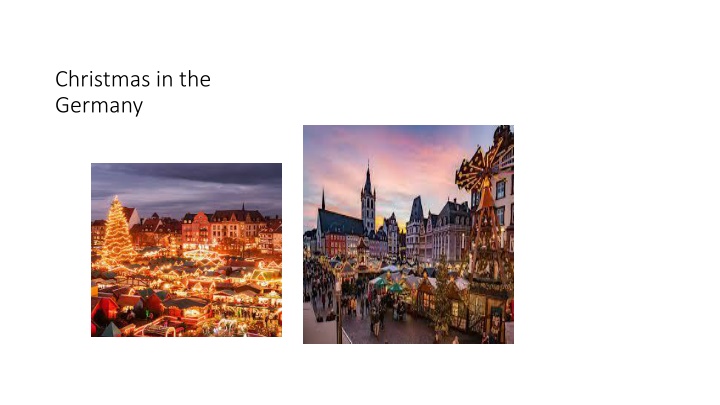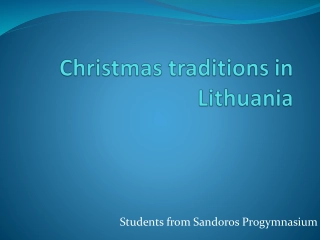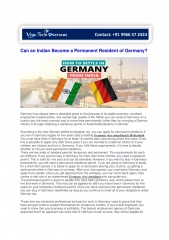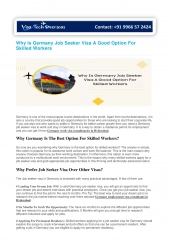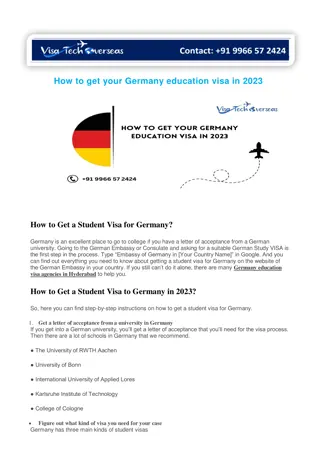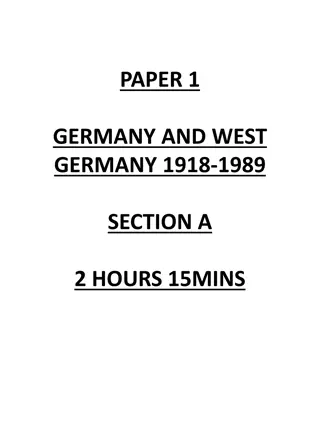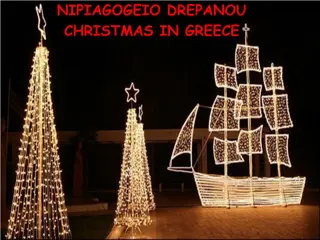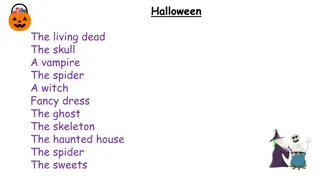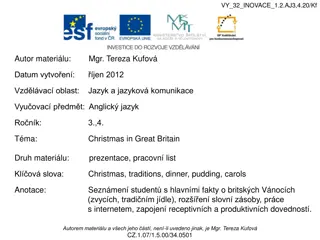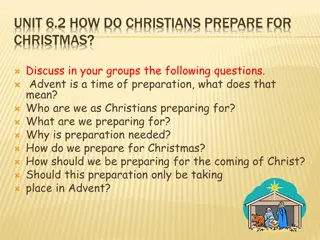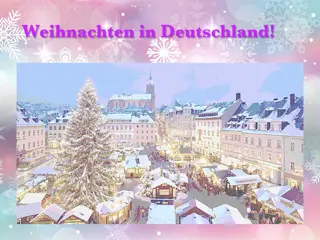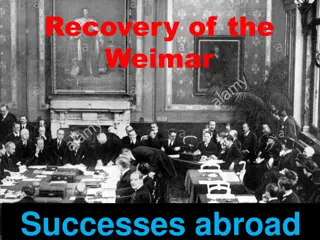Traditional Christmas Celebrations in Germany
In Germany, Christmas traditions hold deep cultural significance. From opening stockings on St. Nicholas Day to celebrating Christmas Eve with the Christkind delivering gifts, the festive season is rich with customs like decorating the Christmas tree and lighting Advent wreaths. German Christmas markets offer a magical atmosphere with activities like ice skating and indulging in glühwein. These traditions reflect the spirit of togetherness and joy during the holiday season in Germany.
Download Presentation

Please find below an Image/Link to download the presentation.
The content on the website is provided AS IS for your information and personal use only. It may not be sold, licensed, or shared on other websites without obtaining consent from the author.If you encounter any issues during the download, it is possible that the publisher has removed the file from their server.
You are allowed to download the files provided on this website for personal or commercial use, subject to the condition that they are used lawfully. All files are the property of their respective owners.
The content on the website is provided AS IS for your information and personal use only. It may not be sold, licensed, or shared on other websites without obtaining consent from the author.
E N D
Presentation Transcript
Christmas in the Germany
10 popular German Christmas 10 popular German Christmas traditions and their meanings traditions and their meanings 1. Stockings are opened on 6th December Children in Germany open their stockings on the morning of Saint Nicholas Day, 6th December. Known as the Feast of Saint Nicholas, this age-old tradition is observed in many European countries, regardless of religious denomination.
2. Christmas is celebrated on Christmas Eve Christmas Eve (Heiliger Abend) is a jam-packed day of celebrations for Germans. Traditionally, many households will spend the day decorating the tree, preparing food for the family and sprucing up the home. As soon as the night draws in, households will gather around the tree. According to tradition, the 'Christkind' (Christ child) delivers the presents when the children are waiting outside the room. A bell will be rung for children to step inside the room, where the family will then sing carols before the bescherung (opening of gifts) begins. Some families head to Christmas Eve services at their local churches afterwards, while others may indulge in a cheese fondu.
3. The Christmas tree is decorated last Traditionally, the tree is only put up in Germany on 24th December. While this now varies from family to family, many of the older generation still deck the halls on the morning of Christmas Eve. The rest of the home is decorated beforehand, but it's just the tree which is saved until last.
4. Placing an Advent wreath on the table Advent wreaths, known as an Adventskranz, is a tradition which the German Lutherans in the 16th century kick-started. Typically, the wreath consists of four candles in a bed of pine cones, berries, dried flowers and various festive ornaments. Most households will bring out the wreath at the beginning of December, lighting one candle each Sunday throughout the month.
5. Christmas markets While the magic of German Christmas markets has spread all around the world, it's a tradition which first derived from Germany. It's thought the origins of Christmas markets can be traced back to the German-speaking part of Europe in the Middle Ages. There really is nothing better than ice skating followed by gl hwein (mulled wine) and a hotdog at one of the best markets...
6. Christmas angel Step into any German house at Christmastime and you'll find an abundance of Christmas angels (Weihnachtsengel) around the home. One of the most popular decorations, the angels are either put on the tree or placed on sideboards. In some families, they are passed down through generations and have special meanings such as hope, joy, love, togetherness, and peace.
7. The white candle of the Advent wreath is lit on Christmas Day While 25th December is still a national holiday in Germany, it's celebrated differently to how we do in England. Traditionally, the family will gather around a heartwarming meal, attend church, children will play with their new toys and the white candle of the Advent wreath (the one in the middle) will be lit.
8. Stollen Perhaps one of the best German Christmas traditions not to mention the tastiest is stollen. The fruit bread, which is made with nuts, spices, candied fruit and powdered sugar, is enjoyed throughout the holiday season. Typically known in Germany as Weihnachtsstollen or Christstollen, this famous festive cake has made its way all around the world and is unsurprisingly loved by all. Look out for it in your local supermarket this Christmas.
9. Sternsinger Sternsigner, which translates to star singers, is when young children dress up as the Three Wise Men and go to visit houses in their neighbourhood with a star on a rod. They will often sing carols to spread good cheer. It derives from Catholic tradition and is also done in some parts of Austria, too.
10. Hand-carved wooden Nutcracker figures Decorative nutcracker figurines, commonly made to resemble a toy soldier, is a common German Christmas tradition. According to German folklore, nutcrackers were given as good luck keepsakes to the family to protect their home. It's thought they would watch over the family, keeping evil spirits and danger at bay.
